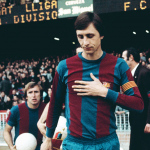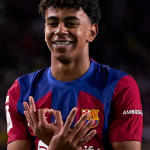
Where will Barcelona play for the next two years?
History of the historic Lluís Companys Olympic Stadium on Montjuic Hill
May 30th, 2023
A few months ago, Barcelona president Joan Laporta presented the Camp Nou renovation project and the need to find a new stadium for the Blaugrana until November 2024. Right from the start, the Lluís Companys Olympic Stadium was identified, better known as Stadio de Montjuïc, named after the hill from where you can see the whole of Barcelona from above.
Montjuic in some ways is the true hub of Barcelona sport, it is there that the main competitions of the 1992 Olympics were staged, with the Lluís Companys Olympic Stadium hosting the athletics competitions, football matches and especially the inauguration ceremony. The sports history of the facility is very long, since 1929, the year it was inaugurated, the Montjuic arena has hosted club and national teams, but also rugby and NFL matches, as well as concerts of great artists such as the one a few days ago by Coldplay or those scheduled for this summer by Beyoncé, The Weeknd and Harry Style. Barcelona will therefore move to a venue with a very long history, which is also architecturally closely linked to the evolution of the city over the last century.
The Lluís Companys Olympic Stadium did not originate with the '92 Olympics but for another historic 20th-century event for the Spanish city, the 1929 Expo. One of the leading exponents of Spanish modernist architecture, Pere Domènech i Roura, was asked to carry out the project, which was completed on 20 May 1929 after a year's work. The layout is perfectly elliptical, with a large athletics track all around the playing field. The external structure is of celebratory royalty, with the long façade of the west stand looking out over the large open square designed overlooked by the Olympic swimming pool, the famous communications tower and the Palau Sant Jordi building, all built for the '92 event.
The beauty of the Lluís Companys Olympic Stadium is precisely that of bringing together a project from the early 1900s, still clearly visible, with the changes to the whole area in the following years and the renovations of the early 1990s, entrusted among others to Vittorio Gregotti, the historic architect of the Marassi stadium in Genoa. It is not difficult to notice the change in style between the first and second rings, with the latter being integrated between '89 and '92, remaining independent from the rest of the structure, almost suspended. Seating capacity was initially 26,000, rising to 60,000 today, which is a problem even for Barcelona, used to being able to accommodate more than 90,000 fans at Camp Nou. Above the arched facade, the major intervention was the canopy, a metal roof over the grandstand made of 65-metre-long beams.
Montjuic will once again become one of the great centers of Spanish football after the stadium previously hosted (from 1997 to 2009) Espanyol's home matches, before Barcelona's second team moved to the RCDE Stadium, between Cornellà and El Prat. King's Cup finals, the Spanish Super Cup and friendlies of the Spanish national team have also been played at the Lluís Companys. The Italian national team has a good memory in the Barcelona stadium since it won the European Under-21 Championship on that pitch in 1996 with the generation of Fabio Cannavaro, Nesta, Totti and Buffon on the pitch.
Athletics has not only used the stadium's large oval track for the Olympics, it has also hosted national rugby matches and a historic American football tournament between the NFL teams of the San Francisco 49ers, Pittsburgh Steelers, Los Angeles Raiders and Denver Broncos. The location is not as convenient as that of Camp Nou, but it is striking and almost overlooks the sea. In the meantime, Barcelona will have to pay 15 to 20 million for rent and various expenses, hoping to add another page of history to that of Lluís Companys in the next year and a half.



















